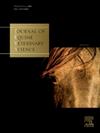Testicular volume measurements obtained with ultrasound images and its association with total sperm count in ejaculates from stallions
IF 1.3
3区 农林科学
Q2 VETERINARY SCIENCES
引用次数: 0
Abstract
Testicular volume is usually related to sperm production capacity. A non-invasive method for assessing testicular measurements has been using ultrasound images, which allows a detailed analysis of the testicular parenchyma and isolate it from the surrounding structures. This study aimed to evaluate the most effective method for measuring testicular volume using ultrasound images and compare it to the total number of sperm per ejaculation, over a year. This was done by either measuring the width of each testicle to get the total testicular width (TTW; cm), or by determining the height, width, and length of both testes to calculate total testicular volume (TTV; cm3). Eight light-breed stallions were followed-up for one-year, testicular measurements using ultrasound were carried out every 15 days, prior to semen collection from each stallion. Semen, without the gel fraction, was evaluated immediately after collection to estimate the total sperm count in the ejaculate (x109). The seasons of the year (summer, autumn, winter and spring) were considered to track the values throughout the year; differences between the means were compared using Tukey's test. Associations between variables were computed using the Pearson correlation method. Results are presented as mean ± standard error of the mean (SEM), and statistical significance was established at P<0.05. Testicular volume varied throughout the year for both TTW and TTV (respectively presented; P<0.0.05), with higher values observed in summer (9.39 ± 0.11; 179.30 ± 4.08), and spring (9.15 ± 0.07; 172.30 ± 2.38), lower values in autumn (8.92 ± 0.09; 166.18 ± 3.83), and winter (8.48 ± 0.09; 156.57 ± 2.79). A moderated correlation was observed between TTW and TTV (R=0.51; p<0.05). For total sperm count in the ejaculate, both summer and spring showed higher values (6.03 ± 0.36 and 6.51 ± 0.34, respectively) compared to autumn and winter (5.00 ± 0.04 and 4.86 ± 0.36, respectively). A moderated correlation was observed between total sperm count in the ejaculate and either TTW (R = 0.6; P>0.05) or TTV (R = 0.54; P>0.05). Testicular dimensions are typically measured using calipers to determine total scrotal width or via ultrasound to calculate TTV. Ultrasound has the advantage of assessing only the testicular parenchyma, whereas caliper measurements also include surrounding structures. However, positioning the ultrasound probe to accurately measure testicular length requires more technical skill due to the positioning of the stallion's testicles within the scrotum. Therefore, obtaining TTW through ultrasound is a valuable tool for assessing testicular volume in stallions.
用超声图像获得的睾丸体积测量及其与种马射精中精子总数的关系
睾丸体积通常与精子生产能力有关。一种评估睾丸测量的非侵入性方法是使用超声图像,它允许对睾丸实质进行详细分析,并将其与周围结构隔离开来。本研究旨在评估使用超声图像测量睾丸体积的最有效方法,并将其与一年内每次射精的精子总数进行比较。这是通过测量每个睾丸的宽度来获得总睾丸宽度(TTW;cm),或通过测定两个睾丸的高度、宽度和长度来计算睾丸总体积(TTV;立方厘米)。对8匹轻型种马进行为期一年的随访,每15天进行一次超声睾丸测量,然后采集每匹种马的精液。收集后立即评估不含凝胶部分的精液,以估计射精中的精子总数(x109)。一年中的季节(夏、秋、冬、春)被认为是跟踪全年的数值;采用Tukey检验比较均值之间的差异。使用Pearson相关法计算变量之间的关联。结果以均数±标准误差(SEM)表示,并以P<;0.05建立统计学意义。TTW和TTV的睾丸体积全年变化(分别呈现;P<0.0.05),夏季较高(9.39±0.11;179.30±4.08),弹簧(9.15±0.07;172.30±2.38),秋季较低(8.92±0.09);(166.18±3.83),冬季(8.48±0.09;156.57±2.79)。TTW与TTV之间有一定的相关性(R=0.51;术中,0.05)。射精总精子数夏季和春季分别为6.03±0.36和6.51±0.34,而秋季和冬季分别为5.00±0.04和4.86±0.36。射精总精子数与TTW (R = 0.6;P>0.05)或TTV (R = 0.54;P> 0.05)。睾丸尺寸通常是用卡尺来测量阴囊总宽度或通过超声波来计算TTV。超声的优点是只评估睾丸实质,而卡尺测量也包括周围结构。然而,定位超声探头以准确测量睾丸长度需要更多的技术技能,因为种马的睾丸在阴囊内的位置。因此,通过超声获得TTW是评估种马睾丸体积的一个有价值的工具。
本文章由计算机程序翻译,如有差异,请以英文原文为准。
求助全文
约1分钟内获得全文
求助全文
来源期刊

Journal of Equine Veterinary Science
农林科学-兽医学
CiteScore
2.70
自引率
7.70%
发文量
249
审稿时长
77 days
期刊介绍:
Journal of Equine Veterinary Science (JEVS) is an international publication designed for the practicing equine veterinarian, equine researcher, and other equine health care specialist. Published monthly, each issue of JEVS includes original research, reviews, case reports, short communications, and clinical techniques from leaders in the equine veterinary field, covering such topics as laminitis, reproduction, infectious disease, parasitology, behavior, podology, internal medicine, surgery and nutrition.
 求助内容:
求助内容: 应助结果提醒方式:
应助结果提醒方式:


